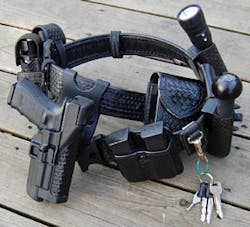I've carried a gun and ancillary related police equipment on my waist daily for somewhere around 30 years. It started with handcuffs, flashlight and baton as I started working uniform security while attending college. I started carrying with a Model 19 Smith & Wesson revolver, two speed strips (later progressing to speed loaders) once I attended a State certified security training program. My duty equipment was brown basket-weave and leather. Sworn in as a Deputy Sheriff after graduating from the Basic Law Enforcement Academy I bought my own black basket-weave rig belt, holster and equipment which was worn by my Sheriff's Office and most LE agencies in my area. Velcro was new to the scene and my trouser belt/duty belt used the hook and pile material as a way to affix the duty belt to your waist. I had purchased a new Model 66 Smith (stainless .357 magnum loaded with .38 special rounds) which was carried in a Bianchi model 27K breakfront holster. Breakfront rigs were all the rage back then as a means to retain your pistol on the street (prior to that "Border Patrol" style holsters were in vogue which only featured a strap across the top of your revolver or at most a thumb-break). Funny thing about breakfront holsters is that they were more secure from the rear. The partial open or in my case fully open holster front actually made getting the gun out from the front easier. The last holster I purchased for my Model 66 was a Gordon Davis Leather Company thumb-break which was by far the best I'd ever owned (I still own the rig and it still looks great).
I was hired by my present agency just as they began the transition from revolver to semi-auto pistol. I was issued a standard leather thumb-break but soon upgraded to a Safariland SSIII holster (now known as Model 070). Plainclothes street narcotics assignment had me wearing a pancake style thumb-break for my department issue 5906 then progressing to a more secure Safariland plainclothes holster which replicated my uniform 070.
When BLACKHAWK! introduced their SERPA holster I bought one of the first and have used a SERPA rig ever since in my plainclothes training bureau assignment. When the Xiphos light was introduced I segued into a plainclothes SERPA holster which allows me to carry the Xiphos weapon-light attached. My tactical rig when running SWAT team and operator training was the SERPA Level 3 on that company's excellent thigh rig. It was natural then for me to then carry a SERPA uniform duty holster. The BLACKHAWK! Level 3 is the fastest security holster I have ever used, bar none. Since then I have upgraded to a Level 3 SERPA for my Xiphos equipped Glock 19. This was the rig I selected for uniform duty carry.
Belt and Accoutrements
In this day and age of blood born diseases being so prevalent it is not a sound idea to wear leather gear on duty. Polymer equipment can be easily disinfected should it be exposed to blood or other body fluids, leather cannot. Further with advanced polymer molding processes equipment fit is much better as is scratch resistance. Uniform and equipment appearance to citizens and suspects conveys the powerful message of your state of readiness and competence. A scratched up leather belt, holster and other equipment on an officer indicates a sloppy ill-prepared officer just like an ill-fitting or wrinkled duty uniform.
(Author's Note: I knew an old beat cop whose belt (and his appearance) looked like heck (the .38 rounds in his belt loops were actually green with corrosion). His attitude said clearly, "I don't care" (because he didn't) and he garnered no respect on the street because of it.)
I would remind officers to inspect holsters, belts and other equipment on a regular basis. Polymers can crack and break and belt loops can loosen or stitches unravel. As I inspected my equipment for this piece I noted my double cuff case which has been with me for years is starting to crack - time to replace it.
My agency provides Uncle Mike's black basket-weave Mirage belts on which I mounted my BLACKHAWK! SERPA Level 3, Bianchi open top dual mag carrier (much faster and just as secure as a flap covered mag carrier), an ASP polymer holster containing my 21 inch ASP baton topped with a Hindi baton cap, a Safariland dual cuff case, another ASP scabbard holds my Streamlight PolyStinger Dual Switch LED flashlight, a back-up Streamlight Strion LED compact light is held in a Uncle Mikes flapped holder, a small key holder and lastly a swivel holster for my portable radio. Two belt keepers are all I use. One is mounted behind my holster to keep my OC spray carrier from interfering with my pistol access. The second keeper is affixed at the rear of my belt.
Real Estate and Placement
As I've gotten older I have more room on my belt to mount gear (that's all I'm sayin'...). Smaller male and female officers may be hard pressed to get the real estate to carry their gear. BDU trousers with thigh pockets offer some options such as carrying a Taser X26 in a pocket holster from DeSantis. I'm not issued a Taser but if I was, I would probably mount it in front of my belt for a cross draw.
Most of my life-saving gear (pistol, spare mags, cuffs, baton) are carried in front of my hips for easier access. Years ago I carried my double cuff case behind my pistol and behind my hip but that caused lower back problems so I moved it up front (easier access with either hand as well). Nowadays I don't carry anything on the belt that keeps my back from being flat against the car seat or anything that could injure my spine should I fall backwards.
Some officers carry a latex glove pouch on their belt. Although I've always had patrol gloves in a pocket or on the dash for quick access as well as having latex gloves readily available, I've never carried them on the belt.
Wrap-Up
The duty belt does more than just serve as some piece of ceremonial uniform gear. It carries, ready at hand, the firearm and equipment we may need to save our very lives. Care must be taken in its selection, placement and maintenance so that it can serve you in its intended function. Look good and perform well on the street by properly attending to your duty belt, holster and gear. Take care of it and it will take care of you.
About the Author
Kevin Davis
Tactical Survival Contributor
Kevin R. Davis retired from the Akron Police Department after 31 years with a total of 39 years in law enforcement. Kevin was a street patrol officer, narcotics detective, full-time use of force, suspect control, and firearms instructor, and detective assigned to the Body Worn Camera Unit. Kevin is the author of Use of Force Investigations: A Manual for Law Enforcement, and is an active consultant and expert witness on use of force incidents. Kevin's website is https://kd-forcetraining.com/

